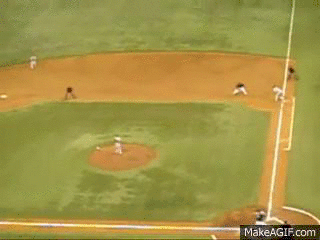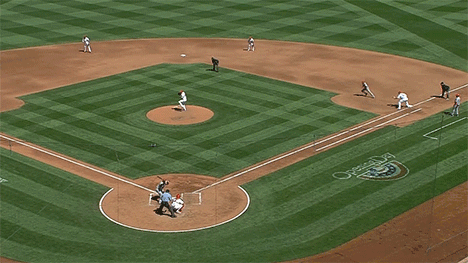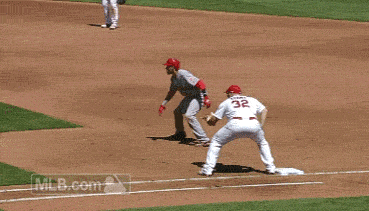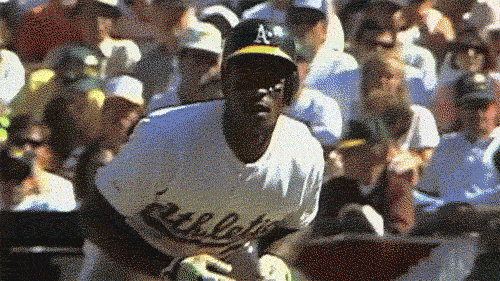Breaking Down the Science of the Stolen Base
What does it take to swipe second? Math and physics lend their advice
/https://tf-cmsv2-smithsonianmag-media.s3.amazonaws.com/filer/6e/37/6e37661a-f8fe-45d4-ba9a-93df00c46e02/42-47880623.jpg)
In the 2014 baseball playoffs, “Who’s on first?” may turn out to be an especially vital question. The games feature the two best and two worst teams in each league in stolen bases: the fleet-footed Royals and Dodgers, and the plodding Orioles and Giants. While stealing bags is clearly not a prerequisite for success, in the seat-gripping drama of the postseason, games (nay, entire series) can come down to a single theft.
Just ask Dave Roberts, who is celebrating the tenth anniversary of what is probably the most significant stolen base in the history of baseball—a steal in Game 4 of the 2004 American League Championship Series that put the Boston Red Sox on a path to their first World Series win since 1918. And just this week, the Royals defeated the Oakland A’s in the American League wild card game in part because of their prowess on the basepaths; they stole seven bases, albeit with one costly failed double steal early in the game. So what are the keys to a successful stolen base, and is it more art or science?
First, some math. There’s a rather basic equation for determining the likelihood of a successful theft: the time it takes for a player to run between first and second base needs to be less than the sum of the time a pitcher takes to deliver the ball to the plate, plus the time the catcher takes to throw the ball to second base.
Physicist David Kagan of California State University at Chico has focused on the first half of that equation as a way of turning his passion for baseball into a teachable moment for his classrooms.
The distance between first and second base is 90 feet, which Kagan divided into its components—the distance of the lead from first base, the distance the runner slides, and the distance he runs in between. Considering the runner to be an object in motion between two fixed points, Kagan devised a simple kinetic model for computing the time it takes to reach second base, dependent on five variables: the runner’s acceleration when starting the run (“the jump”), his deceleration when beginning to slide, the top speed he reaches during the run, his speed when reaching second base, and the distance of his lead (see the complete model here).
Every mathematical model is a simplification of reality. For example, the variables above are kept constant, even though it’s impossible for a human to run at constant speed. But to test its accuracy, Kagan needed to examine some real data. Although Major League Baseball’s Advanced Media is able to track the position and movement of every player on the field, Kagan was denied his request for footage and so had to do it the grass-roots way—YouTube. He tracked down fan-cam video of Carl Crawford’s sixth stolen base in a May 3, 2009, game between the Tampa Bay Rays and Boston Red Sox. He then manually marked Crawford’s position as he moved between first and second, watching the video frame by frame.

When he fit the data to the model, he found the model to be a good predictor of what actually happened—given the technological limitations of using video shot from the nosebleed seats.
But the real payoff came when examining the sensitivity of each variable in the model—in other words, how much did each of the five parameters influence the outcome? Using a mathematical technique called a sensitivity analysis, Kagan determined the runner’s top speed to be most important, which was no big surprise. The average speed is 3.5 seconds, and Billy Hamilton, who stole second in 3.17 seconds in the minor leagues is among the top base thieves in the National League this year.


The second most important variable was the jump. From there, things took an unexpected turn. “The lead isn’t as important as you might think,” Kagan says. “I would have bet the lead would be in the top 3, but the third [most important factor] was the final speed when reaching second base.”
In other words, sliding slows you down, and you want to keep your speed when you hit the bag as high as possible. When running to first, you can run through the bag in foul territory, but doing that at second would result in a sure out. To minimize the time when they begin to slow down, “baserunners slide past the base and grab it on their way by,” Kagan says, noting that more and more players seem to be using this tactic.
But while Kagan’s model shows that a runner’s top speed is the most important factor, history shows that speed doesn’t always win out. In 1974, Oakland A’s owner and box-buster Charlie Finley signed All-American sprinter Herb Washington to use solely as a pinch runner. Despite setting world records in the 50-yard dash, Washington was successful on only 64.4 percent of his steal attempts, slightly better than that year’s league average of 62 percent and well below the hallowed 75 percent threshold cited by sabermetricians for a stolen base attempt being worth it. Why didn’t Washington thieve like Rickey Henderson?

Aside from the possibility that Washington was not good at getting a jump, that other half of the equation, the pitcher and catcher, have a lot to do with whether or not a steal is successful. Casual fans tend to think that the catcher is primarily responsible for whether a runner gets thrown out--it’s his job, after all, to make the throw. But those who play the game know better.
“The majority of it lies on the pitcher,” says Steve Yeager, who backstopped the Los Angeles Dodgers from 1972-85 and twice led the National League in caught stealing percentage. While the catcher has to be quick to transfer the ball from his mitt to his throwing hand and make an accurate throw, the key is the pitcher’s time to home plate, he says.
Back in his day, players measured times to home plate as “fast” or “slow” and took it upon themselves to keep track of which pitchers were easier to steal on. “When I played, my pitching staff knew that if they gave me half a chance, I would throw someone out,” Yeager says. “You remembered who could run and who couldn’t.”
Nowadays, the statistical revolution that has swept through baseball like The Wave has given coaches like Yeager access to data on the speed of every pitcher’s delivery in every possible situation: the count, inning, score, probably even the color of the umpire’s socks. Baseball has changed from a game directed largely by instinct and tradition to a mathematician’s playground where probability functions are the monkey bars. Or as Yeager phrases it: “The information highway is now a super expressway and not a two-lane road.”
Per Baseball America, the goal for many teams is to have their pitchers deliver a pitch in about 1.3 seconds; those with a quick sidestep can get the ball in as fast as 1.1 to 1.2 seconds. A pitcher who takes 1.5 seconds or more is going to be taken advantage of by speedy baserunners. On the other end of the battery, a great catcher will deliver the ball to second base in 1.8 or 1.9 seconds. Looking back to the equation, you can see why a speedster like Billy Hamilton can beat almost everyone other than the quickest pitcher-batter combinations.
The handedness of the pitcher also plays a big role—one analysis showed that between 2002 and 2008, 66 percent of stolen base attempts were successful against left-handers versus 72 percent against right-handers, since left-handers face a runner leading off first.
But Rangers third base coach Gary Pettis (no slouch himself, stealing 354 bases in his 11-year career) is careful to point out that not everything in baseball should be decided by an algorithm. Part of his responsibility is to give the steal sign to a runner on first base.
“We do record their [the pitchers’] times,” he says, but whether or not they try to steal depends on reading the particulars of a given situation. “Just because a pitcher appears to be quick doesn’t mean he’s always going to be that way.” While teams have more data than they could have ever imagined back in the 1980s, “it’s not cut and dry,” Pettis says.
“You look at them, but you don’t necessarily let them deter you from attempting to steal,” he says. As the Royals head further into the playoffs against the Los Angeles Angels, keep an eye on anyone who makes it to first and then break out the stopwatch.

